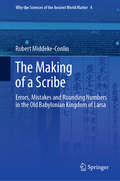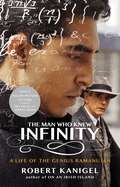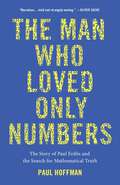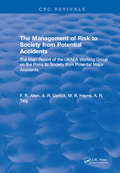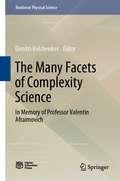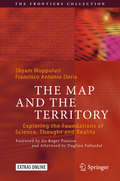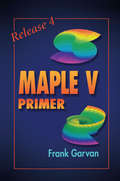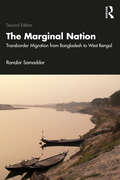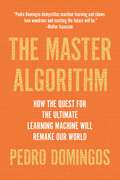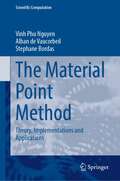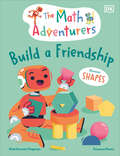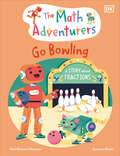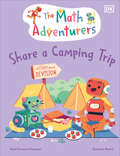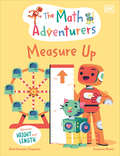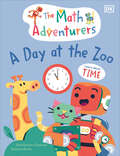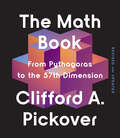- Table View
- List View
The Making of a Scribe: Errors, Mistakes and Rounding Numbers in the Old Babylonian Kingdom of Larsa (Why the Sciences of the Ancient World Matter #4)
by Robert Middeke-ConlinThis book presents a novel methodology to study economic texts. The author investigates discrepancies in these writings by focusing on errors, mistakes, and rounding numbers. In particular, he looks at the acquisition, use, and development of practical mathematics in an ancient society: The Old Babylonian kingdom of Larsa (beginning of the second millennium BCE Southern Iraq). In so doing, coverage bridges a gap between the sciences and humanities. Through this work, the reader will gain insight into discrepancies encountered in economic texts in general and rounding numbers in particular. They will learn a new framework to explain error as a form of economic practice. Researchers and students will also become aware of the numerical and metrological basis for calculation in these writings and how the scribes themselves conceptualized value. This work fills a void in Assyriological studies. It provides a methodology to explore, understand, and exploit statistical data. The anlaysis also fills a void in the history of mathematics by presenting historians of mathematics a method to study practical texts. In addition, the author shows the importance mathematics has as a tool for ancient practitioners to cope with complex economic processes. This serves as a useful case study for modern policy makers into the importance of education in any economy.
The Malliavin Calculus
by Denis R. BellThis introduction to Malliavin's stochastic calculus of variations is suitable for graduate students and professional mathematicians. Author Denis R. Bell particularly emphasizes the problem that motivated the subject's development, with detailed accounts of the different forms of the theory developed by Stroock and Bismut, discussions of the relationship between these two approaches, and descriptions of a variety of applications.The first chapter covers enough technical background to make the subsequent material accessible to readers without specialized knowledge of stochastic analysis. Succeeding chapters examine the functional analytic and variational approaches (with extensive explorations of the work of Stroock and Bismut); and elementary derivation of Malliavin's inequalities and a discussion of the different forms of the theory; and the non-degeneracy of the covariance matrix under Hormander's condition. The text concludes with a brief survey of applications of the Malliavin calculus to problems other than Hormander's.
The Man Who Counted: A Collection of Mathematical Adventures
by Malba Tahan Alastair Reid Leslie Clark Patricia Reid Baquero“A great storyteller.”—Paulo Coelho, author of The Alchemist Malba Tahan is the creation of a celebrated Brazilian mathematician looking for a way to bring some of the mysteries and pleasures of mathematics to a wider public. The adventures of Beremiz Samir, The Man Who Counted, take the reader on a journey in which, time and again, Samir summons his extraordinary mathematical powers to settle disputes, give wise advice, overcome dangerous enemies, and win for himself fame, fortune, and rich rewards. We learn of previous mathematicians and come to admire Samir’s wisdom and patience. In the grace of Tahan’s telling, these stories hold unusual delights for the reader.
The Man Who Knew Infinity: A Life of the Genius Ramanujan
by Robert KanigelNOW A MAJOR MOTION PICTURE STARRING JEREMY IRONS AND DEV PATEL! A moving and enlightening look at the unbelievable true story of how gifted prodigy Ramanujan stunned the scholars of Cambridge University and revolutionized mathematics.In 1913, a young unschooled Indian clerk wrote a letter to G H Hardy, begging the preeminent English mathematician's opinion on several ideas he had about numbers. Realizing the letter was the work of a genius, Hardy arranged for Srinivasa Ramanujan to come to England. Thus began one of the most improbable and productive collaborations ever chronicled. With a passion for rich and evocative detail, Robert Kanigel takes us from the temples and slums of Madras to the courts and chapels of Cambridge University, where the devout Hindu Ramanujan, "the Prince of Intuition," tested his brilliant theories alongside the sophisticated and eccentric Hardy, "the Apostle of Proof." In time, Ramanujan's creative intensity took its toll: he died at the age of thirty-two, but left behind a magical and inspired legacy that is still being plumbed for its secrets today.
The Man Who Loved Only Numbers: The Story of Paul Erdos and the Search for Mathematical Truth
by Paul Hoffman"A funny, marvelously readable portrait of one of the most brilliant and eccentric men in history." --The Seattle Times Paul Erdos was an amazing and prolific mathematician whose life as a world-wandering numerical nomad was legendary. He published almost 1500 scholarly papers before his death in 1996, and he probably thought more about math problems than anyone in history. Like a traveling salesman offering his thoughts as wares, Erdos would show up on the doorstep of one mathematician or another and announce, "My brain is open." After working through a problem, he'd move on to the next place, the next solution. Hoffman's book, like Sylvia Nasar's biography of John Nash, A Beautiful Mind, reveals a genius's life that transcended the merely quirky. But Erdos's brand of madness was joyful, unlike Nash's despairing schizophrenia. Erdos never tried to dilute his obsessive passion for numbers with ordinary emotional interactions, thus avoiding hurting the people around him, as Nash did. Oliver Sacks writes of Erdos: "A mathematical genius of the first order, Paul Erdos was totally obsessed with his subject--he thought and wrote mathematics for nineteen hours a day until the day he died. He traveled constantly, living out of a plastic bag, and had no interest in food, sex, companionship, art--all that is usually indispensable to a human life."The Man Who Loved Only Numbers is easy to love, despite his strangeness. It's hard not to have affection for someone who referred to children as "epsilons," from the Greek letter used to represent small quantities in mathematics; a man whose epitaph for himself read, "Finally I am becoming stupider no more"; and whose only really necessary tool to do his work was a quiet and open mind. Hoffman, who followed and spoke with Erdos over the last 10 years of his life, introduces us to an undeniably odd, yet pure and joyful, man who loved numbers more than he loved God--whom he referred to as SF, for Supreme Fascist. He was often misunderstood, and he certainly annoyed people sometimes, but Paul Erdos is no doubt missed. --Therese Littleton
The Man Who Saved Geometry: The Multidimensional Mind of Donald Coxeter
by Siobhan RobertsAn illuminating biography of one of the greatest geometers of the twentieth centuryDriven by a profound love of shapes and symmetries, Donald Coxeter (1907–2003) preserved the tradition of classical geometry when it was under attack by influential mathematicians who promoted a more algebraic and austere approach. His essential contributions include the famed Coxeter groups and Coxeter diagrams, tools developed through his deep understanding of mathematical symmetry. The Man Who Saved Geometry tells the story of Coxeter&’s life and work, placing him alongside history&’s greatest geometers, from Pythagoras and Plato to Archimedes and Euclid—and it reveals how Coxeter&’s boundless creativity reflects the adventurous, ever-evolving nature of geometry itself. With an incisive, touching foreword by Douglas R. Hofstadter, The Man Who Saved Geometry is an unforgettable portrait of a visionary mathematician.
The Man from the Future: The Visionary Life of John von Neumann
by Ananyo BhattacharyaAn electrifying biography of one of the most extraordinary scientists of the twentieth century and the world he made. The smartphones in our pockets and computers like brains. The vagaries of game theory and evolutionary biology. Nuclear weapons and self-replicating spacecrafts. All bear the fingerprints of one remarkable, yet largely overlooked, man: John von Neumann. Born in Budapest at the turn of the century, von Neumann is one of the most influential scientists to have ever lived. A child prodigy, he mastered calculus by the age of eight, and in high school made lasting contributions to mathematics. In Germany, where he helped lay the foundations of quantum mechanics, and later at Princeton, von Neumann’s colleagues believed he had the fastest brain on the planet—bar none. He was instrumental in the Manhattan Project and the design of the atom bomb; he helped formulate the bedrock of Cold War geopolitics and modern economic theory; he created the first ever programmable digital computer; he prophesized the potential of nanotechnology; and, from his deathbed, he expounded on the limits of brains and computers—and how they might be overcome. Taking us on an astonishing journey, Ananyo Bhattacharya explores how a combination of genius and unique historical circumstance allowed a single man to sweep through a stunningly diverse array of fields, sparking revolutions wherever he went. The Man from the Future is an insightful and thrilling intellectual biography of the visionary thinker who shaped our century.
The Management of Risk to Society from Potential Accidents: The Main Report of the UKAEA Working Group on the Risks to Society from Potential Major Accidents
by F.R. AllenThe main report of the UKAEA (United Kingdom Atomic Energy Authority) Working Group on the Risks to Society from Potential Major Accidents, with an Executive Summary
The Manga Guide to Calculus
by Becom Co. Ltd. Hiroyuki Kojima Shin TogamiNoriko is just getting started as a junior reporter for the Asagake Times. She wants to cover the hard-hitting issues, like world affairs and politics, but does she have the smarts for it? Thankfully, her overbearing and math-minded boss, Mr. Seki, is here to teach her how to analyze her stories with a mathematical eye.In The Manga Guide to Calculus, you'll follow along with Noriko as she learns that calculus is more than just a class designed to weed out would-be science majors. You'll see that calculus is a useful way to understand the patterns in physics, economics, and the world around us, with help from real-world examples like probability, supply and demand curves, the economics of pollution, and the density of Shochu (a Japanese liquor).Mr. Seki teaches Noriko how to:–Use differentiation to understand a function's rate of change–Apply the fundamental theorem of calculus, and grasp the relationship between a function's derivative and its integral–Integrate and differentiate trigonometric and other complicated functions–Use multivariate calculus and partial differentiation to deal with tricky functions–Use Taylor Expansions to accurately imitate difficult functions with polynomialsWhether you're struggling through a calculus course for the first time or you just need a painless refresher, you'll find what you're looking for in The Manga Guide to Calculus.This EduManga book is a translation from a bestselling series in Japan, co-published with Ohmsha, Ltd. of Tokyo, Japan.
The Manga Guide to Regression Analysis
by Co Ltd Trend Shin Takahashi Iroha InoueLike a lot of people, Miu has had trouble learning regression analysis. But with new motivation—in the form of a handsome but shy customer—and the help of her brilliant café coworker Risa, she’s determined to master it.Follow along with Miu and Risa in The Manga Guide to Regression Analysis as they calculate the effect of temperature on iced tea orders, predict bakery revenues, and work out the probability of cake sales with simple, multiple, and logistic regression analysis. You’ll get a refresher in basic concepts like matrix equations, inverse functions, logarithms, and differentiation before diving into the hard stuff. Learn how to:–Calculate the regression equation–Check the accuracy of your equation with the correlation coefficient–Perform hypothesis tests and analysis of variance, and calculate confidence intervals–Make predictions using odds ratios and prediction intervals–Verify the validity of your analysis with diagnostic checks–Perform chi-squared tests and F-tests to check the goodness of fitWhether you’re learning regression analysis for the first time or have just never managed to get your head around it, The Manga Guide to Regression Analysis makes mastering this tricky technique straightforward and fun.
The Many Faces of Maxwell, Dirac and Einstein Equations
by Jr Waldyr A. Rodrigues Edmundo Capelas de OliveiraThis book is an exposition of the algebra and calculus of differentialforms, of the Clifford and Spin-Clifford bundle formalisms, and of vistas to aformulation of important concepts of differential geometry indispensable for anin-depth understanding of space-time physics. The formalism discloses the hidden geometrical nature of spinor fields. Maxwell, Dirac and Einstein fields are shown to have representatives by objectsof the same mathematical nature, namely sections of an appropriate Cliffordbundle. This approach reveals unity in diversity and suggests relationshipsthat are hidden in the standard formalisms and opens new paths for research. This thoroughly revised second edition also adds three new chapters: on the Cliffordbundle approach to the Riemannian or semi-Riemannian differential geometry ofbranes; on Komar currents in the context of the General Relativity theory; andan analysis of the similarities and main differences between Dirac, Majoranaand ELKO spinor fields. The exercises with solutions, thecomprehensive list of mathematical symbols, and the list of acronyms andabbreviations are provided for self-study for students as well as for classes. From the reviews of the firstedition: "The text is written in a veryreadable manner and is complemented with plenty of worked-out exercises whichare in the style of extended examples. . . . their book could also serve as atextbook for graduate students in physics or mathematics. " (AlbertoMolgado, Mathematical Reviews, 2008 k)
The Many Facets of Complexity Science: In Memory of Professor Valentin Afraimovich (Nonlinear Physical Science)
by Dimitri VolchenkovThis book explores recent developments in theoretical research and data analysis of real-world complex systems, organized in three parts, namely Entropy, information, and complexity functions Multistability, oscillations, and rhythmic synchronization Diffusions, rotation, and convection in fluids The collection of works devoted to the memory of Professor Valentin Afraimovich provides a deep insight into the recent developments in complexity science by introducing new concepts, methods, and applications in nonlinear dynamical systems covering physical problems and mathematical modelling relevant to economics, genetics, engineering vibrations, as well as classic problems in physics, fluid and climate dynamics, and urban dynamics. The book facilitates a better understanding of the mechanisms and phenomena in nonlinear dynamics and develops the corresponding mathematical theory to apply nonlinear design to practical engineering. It can be read by mathematicians, physicists, complex systems scientists, IT specialists, civil engineers, data scientists, and urban planners.
The Map and the Territory
by Shyam Wuppuluri Francisco Antonio DoriaThis volume presents essays by pioneering thinkers including Tyler Burge, Gregory Chaitin, Daniel Dennett, Barry Mazur, Nicholas Humphrey, John Searle and Ian Stewart. Together they illuminate the Map/Territory Distinction that underlies at the foundation of the scientific method, thought and the very reality itself. It is imperative to distinguish Map from the Territory while analyzing any subject but we often mistake map for the territory. Meaning for the Reference. Computational tool for what it computes. Representations are handy and tempting that we often end up committing the category error of over-marrying the representation with what is represented, so much so that the distinction between the former and the latter is lost. This error that has its roots in the pedagogy often generates a plethora of paradoxes/confusions which hinder the proper understanding of the subject. What are wave functions? Fields? Forces? Numbers? Sets? Classes? Operators? Functions? Alphabets and Sentences? Are they a part of our map (theory/representation)? Or do they actually belong to the territory (Reality)? Researcher, like a cartographer, clothes (or creates?) the reality by stitching multitudes of maps that simultaneously co-exist. A simple apple, for example, can be analyzed from several viewpoints beginning with evolution and biology, all the way down its microscopic quantum mechanical components. Is there a reality (or a real apple) out there apart from these maps? How do these various maps interact/intermingle with each other to produce a coherent reality that we interact with? Or do they not?Does our brain uses its own internal maps to facilitate “physicist/mathematician” in us to construct the maps about the external territories in turn? If so, what is the nature of these internal maps? Are there meta-maps? Evolution definitely fences our perception and thereby our ability to construct maps, revealing to us only those aspects beneficial for our survival. But the question is, to what extent? Is there a way out of the metaphorical Platonic cave erected around us by the nature? While “Map is not the territory” as Alfred Korzybski remarked, join us in this journey to know more, while we inquire on the nature and the reality of the maps which try to map the reality out there. The book also includes a foreword by Sir Roger Penrose and an afterword by Dagfinn Follesdal.
The Maple V Primer, Release 4
by Frank GarvanLearn how to use the modern techniques offered by Maple V, a powerful and popular computer algebra system. The Maple V Primer: Release 4 covers all the basic topics a reader needs to know to use Maple V in its major revision encompassed in Release 4 to do algebra and calculus, solve equations, graph 2- and 3-dimensional plots, perform simple programming tasks, and prepare mathematical documents.Every common command and function is supported by a specific example, so you won't waste time struggling with the syntax. Graphs, plots, and other Maple output are provided along with the syntax, so the user knows what to expect when she or he uses a particular command. And all the examples come with a short discussion, answering questions you might have about applying the example to your own work. This is a painless - even fun - way to learn how to use Maple V.
The Marginal Nation: Transborder Migration from Bangladesh to West Bengal
by Ranabir SamaddarThe Marginal Nation analyses the realities of transborder migration in the South Asia region going beyond the domains of economics and demography. It provides an in-depth look into the historical, cultural and geographic dimensions of migration across the India–Bangladesh border that challenges fixed definitions of borders, nations and identities.Drawing from extensive fieldwork, the author encapsulates the lives and aspirations of migrants exploring the social affinities and historical ties that bind people across territories and ‘marginalises’ national identity. The book chronicles the lived experiences of migrants and their everyday lives, conflicts and contradictions. It pits these narratives against ‘national’ concerns over security, statehood, and demarcated borders interrogating their immutability in the South Asian context. This revised edition reflects upon the significance and relevance of the book to migration and refugee studies in South Asia and beyond twenty-five years after it was first published.A classic, this book will be of interest to students and scholars in the fields of political science, sociology, history, human rights studies, refugee studies, demography and South Asian studies.
The Master Algorithm: How the Quest for the Ultimate Learning Machine Will Remake Our World
by Pedro DomingosAlgorithms increasingly run our lives. They find books, movies, jobs, and dates for us, manage our investments, and discover new drugs. More and more, these algorithms work by learning from the trails of data we leave in our newly digital world. Like curious children, they observe us, imitate, and experiment. And in the world’s top research labs and universities, the race is on to invent the ultimate learning algorithm: one capable of discovering any knowledge from data, and doing anything we want, before we even ask. Machine learning is the automation of discovery--the scientific method on steroids--that enables intelligent robots and computers to program themselves. No field of science today is more important yet more shrouded in mystery. Pedro Domingos, one of the field’s leading lights, lifts the veil for the first time to give us a peek inside the learning machines that power Google, Amazon, and your smartphone. He charts a course through machine learning’s five major schools of thought, showing how they turn ideas from neuroscience, evolution, psychology, physics, and statistics into algorithms ready to serve you. Step by step, he assembles a blueprint for the future universal learner--the Master Algorithm--and discusses what it means for you, and for the future of business, science, and society. If data-ism is today’s rising philosophy, this book will be its bible. The quest for universal learning is one of the most significant, fascinating, and revolutionary intellectual developments of all time. A groundbreaking book, The Master Algorithm is the essential guide for anyone and everyone wanting to understand not just how the revolution will happen, but how to be at its forefront.
The Material Point Method: Theory, Implementations and Applications (Scientific Computation)
by Vinh Phu Nguyen Alban de Vaucorbeil Stephane BordasThis book provides an introduction to the fundamental theory, practical implementation, and core and emerging applications of the material point method (MPM) and its variants. The MPM combines the advantages of both finite element analysis (FEM) and meshless/meshfree methods (MMs) by representing the material by a set of particles overlaid on a background mesh that serves as a computational scratchpad.The book shows how MPM allows a robust, accurate, and efficient simulation of a wide variety of material behaviors without requiring overly complex implementations. MPM and its variants have been shown to be successful in simulating a large number of high deformation and complicated engineering problems such as densification of foam, sea ice dynamics, landslides, and energetic device explosions, to name a few, and have recently found applications in the movie industry. It is hoped that this comprehensive exposition on MPM variants and their applications will not only provide an opportunity to re-examine previous contributions, but also to re-organize them in a coherent fashion and in anticipation of new advances.Sample algorithms for the solutions of benchmark problems are provided online so that researchers and graduate students can modify these algorithms and develop their own solution algorithms for specific problems. The goal of this book is to provide students and researchers with a theoretical and practical knowledge of the material point method to analyze engineering problems, and it may help initiate and promote further in-depth studies on the subjects discussed.
The Math Adventurers Build a Friendship: Discover Shapes (The Math Adventurers)
by Sital Gorasia ChapmanJoin two friendly and funny robots, Beep and Boots, as they learn all about time and discover that math is everywhere they look.Beep the robot would love nothing more than to have her own pet, like her friends do. One morning she gets a surprise delivery – a parcel containing circles, squares, triangles, and pentagons for her to make her own robot cat! Beep realizes that she can&’t make a pet pal from flat, two-dimensional shapes so, with a flash of magic, the shapes become three-dimensional spheres, cubes, and pyramids. Join Beep as she tries different ways of putting shapes together to build her robot cat and make a best friend forever.This fun and educational math book for children features: - A fun and engaging introduction to shapes for children aged 5-7.- Lively illustrations and rhyming text that brings the characters and math topics to life.- Key math topics including shapes, time, measurements, division, and fractions – all essential learning for this age group.- Illustrations that are in a non-gendered color palette, making the traditionally male subject relatable for all genders.- A relatable storyline for young readers, encouraging them to look for math in their homes and environments, and seeing how, often without even knowing it, they use math everyday. Characterful illustrations and rhyming text bring Beep and Boots to life. Children aged 5–7 will love seeing the adventures the robot duo go on and will learn key mathematical concepts concerning time in a gentle, fun way, including telling the time and hours, minutes, and seconds. Questions at the end of the book reinforce learning and encourage kids to look at the math they can see in the world around them.At DK, we believe in the power of discovery. So why stop there?The Math Adventurers series uses everyday scenarios to show how math is all around us, making this difficult subject more accessible. If you loved The Math Adventurers: Chip and Christine Build a Friendship, then why not try The Math Adventurers: A Day at the Zoo!
The Math Adventurers Go Bowling (The Math Adventurers)
by Sital Gorasia ChapmanJoin two friendly and funny robots, Beep and Boots, as they learn all about fractions and discover that math is everywhere they look.Beep and Boots are competing with their friends in a bowling competition. After they’ve figured out the best way to split into teams, the game is on! Who will knock down half the pins on their first try? Will anyone manage three-quarters of the pins? Watch Beep and Boots as they become excellent bowlers—and learn a lot about fractions.Characterful illustrations and rhyming text bring Beep and Boots to life. Children ages 5–7 will love seeing the adventures the robot duo go on and will learn key mathematical concepts concerning fractions in a gentle, fun way. A visual glossary and math questions at the end of the book reinforce learning and encourage kids to look at the math they can see in the world around them.
The Math Adventurers Share a Camping Trip: A Story About Division (The Math Adventurers)
by Sital Gorasia ChapmanJoin two friendly and funny robots, Beep and Boots, as they learn all about division and discover that math is everywhere they look.Beep and Boots are going on a camping trip in the great outdoors. They've got a warm sleeping bag each, a snuggly blanket each, and marshmallows to share. But they realize there are not enough tent pegs! Can they learn to divide up what they have and put up their tents before it's time for bed?Characterful illustrations and rhyming text bring Beep and Boots to life. Children ages 5-7 will love seeing the adventures the robot duo go on and will learn key mathematical concepts concerning division in a gentle, fun way. A visual glossary and math questions at the end of the book reinforce learning and encourage kids to look at the math they can see in the world around them.
The Math Adventurers: Discover Height and Length (The Math Adventurers)
by Sital Gorasia ChapmanJoin two friendly and funny robots, Beep and Boots, as they learn all about measuring and discover that math is everywhere they look.Beep and Boots have an exciting, fun-packed day planned at the amusement park. The pals cannot wait to enjoy all the rides together. But when they check their heights, Boots is not tall enough to go on a lot of the rides. And going to an amusement park is no fun if you can&’t share it with friends. Will Beep be able to come up with a solution so the pair can go on the really high Star Drop ride? Wheeeeee! This fun and educational math book for children features: - A fun and engaging introduction to measurements for children aged 5-7.- Lively illustrations and rhyming text that brings the characters and math topics to life.- Key math topics including shapes, time, measurements, division, and fractions – all essential learning for this age group.- Illustrations that are in a non-gendered color palette, making the traditionally male subject relatable for all genders.- A relatable storyline for young readers, encouraging them to look for math in their homes and environments, and seeing how, often without even knowing it, they use math everyday. The characterful illustrations and rhyming text in the pages of this book bring Beep and Boots to life! Children aged 5–7 will love seeing the adventures the robot duo go on and will learn key mathematical concepts about measuring in a gentle, fun way. A series of questions at the end of the book reinforce learning and encourage kids to look at the math they can see in the world around them. At DK, we believe in the power of discovery. So why stop there?The Math Adventurers series uses everyday scenarios to show how math is all around us, making this difficult subject more accessible. If you enjoyed The Math Adventurers: Measure Up, then you&’ll love The Math Adventurers: A Day at the Zoo, which introduces children to telling the time!
The Math Adventurers: Learn About Time (The Math Adventurers)
by Sital Gorasia ChapmanJoin two friendly and funny robots, Beep and Boots, as they learn all about time and discover that math is everywhere they look.Beep and Boots are looking forward to a day out at the zoo, especially getting to see their favorite animal – the giraffe. But they have to keep an eye on the time else they&’ll miss feeding time! It&’s all too easy to get distracted by lions, tigers, and tasty snacks – 15 minutes here, half an hour there! Pretty soon, Beep and Boots realize they might be late. Will they make it to the giraffe enclosure in time? This fun and educational math book for children features: - A fun and engaging introduction to telling the time for children aged 5-7.- Lively illustrations and rhyming text that brings the characters and math topics to life.- Key math topics including shapes, time, measurements, division, and fractions – all essential learning for this age group.- Illustrations that are in a non-gendered color palette, making the traditionally male subject relatable for all genders.- A relatable storyline for young readers, encouraging them to look for math in their homes and environments, and seeing how, often without even knowing it, they use math everyday.Characterful illustrations and rhyming text bring Beep and Boots to life. Children aged 5–7 will love seeing the adventures the robot duo go on and will learn key mathematical concepts concerning time in a gentle, fun way, including telling the time and hours, minutes, and seconds. Questions at the end of the book reinforce learning and encourage kids to look at the math they can see in the world around them.At DK, we believe in the power of discovery. So why stop there?The Math Adventurers series uses everyday scenarios to show how math is all around us, making this difficult subject more accessible. If you loved The Math Adventurers: A Day at the Zoo, then you&’ll love The Math Adventurers: Chip and Christine Build a Friendship!
The Math Adventurers: Make a Difference (The Math Adventurers)
by Sital Gorasia ChapmanJoin two friendly and funny robots, Beep and Boots, as they learn all about money and discover that math is everywhere they look.This educational book for 5-7 year olds introduces money through an adventure story featuring two robots as they organize a school fair.Characterful illustrations and rhyming text bring Beep and Boots to life. Children will love joining the robot duos’ adventures and learning core mathematical concepts about money in a gentle, fun way. A visual glossary and math questions are featured throughout the book to reinforce learning.This fun and educational math book for children features: A fun and engaging introduction to money for children aged 5-7.Lively illustrations and rhyming text that bring the characters and math topics to life.Important math topics including shapes, time, measurements, division, and fractions, which are all essential topics for this age group.Beep and Boots notice that their library needs more books so they arrange a school fair to raise money. The bustling fair is packed with an arts and crafts table, a bouncy castle, and more. The pair work hard, counting out change and adding up their takings. Will they raise enough money to fill the library? Watch Beep and Boots as they become fundraisers–and learn about money.At DK, we believe in the power of discovery. So why stop here?The Math Adventurers series uses everyday scenarios to show how math is all around us, making this difficult subject more accessible. If you loved The Math Adventurers: Make a Difference, then why not try Build a Friendship, A Day at the Zoo, or Measure Up?
The Math Book (DK Big Ideas)
by DKLearn about the most important mathematical ideas, theorems, and movements in The Math Book.Part of the fascinating Big Ideas series, this book tackles tricky topics and themes in a simple and easy to follow format. Learn about Math in this overview guide to the subject, brilliant for novices looking to find out more and experts wishing to refresh their knowledge alike! The Math Book brings a fresh and vibrant take on the topic through eye-catching graphics and diagrams to immerse yourself in. This captivating book will broaden your understanding of Math, with:- More than 85 ideas and events key to the development of mathematics- Packed with facts, charts, timelines and graphs to help explain core concepts- A visual approach to big subjects with striking illustrations and graphics throughout- Easy to follow text makes topics accessible for people at any level of understandingThe Math Book is a captivating introduction to the world&’s most famous theorems, mathematicians and movements, aimed at adults with an interest in the subject and students wanting to gain more of an overview. Charting the development of math around the world from Babylon to Bletchley Park, this book explains how math help us understand everything from patterns in nature to artificial intelligence.Your Math Questions, Simply ExplainedWhat is an imaginary number? Can two parallel lines ever meet? How can math help us predict the future? This engaging overview explores answers to big questions like these and how they contribute to our understanding of math. If you thought it was difficult to learn about topics like algebra and statistics, The Math Book presents key information in an easy to follow layout. Learn about the history of math, from ancient ideas such as magic squares and the abacus to modern cryptography, fractals, and the final proof of Fermat&’s Last Theorem.The Big Ideas SeriesWith millions of copies sold worldwide, The Math Book is part of the award-winning Big Ideas series from DK. The series uses striking graphics along with engaging writing, making big topics easy to understand.
The Math Book: From Pythagoras to the 57th Dimension (Union Square & Co. Milestones)
by Clifford A. PickoverMath's infinite mysteries unfold in this updated edition of the award-winning The Math Book. Beginning millions of years ago with ancient &“ant odometers,&” and moving through time to our modern-day quest for higher dimensions, prolific polymath Clifford Pickover covers major milestones in mathematical history. Among the numerous concepts readers will encounter as they dip into this inviting anthology: cicada-generated prime numbers, magic squares, and the butterfly effect. Each topic is presented in a lavishly illustrated spread, including formulas and real-world applications of the theorems. This reissue includes four new entries: 2013 (Bounded Gaps Between Primes), 2015 (Erdős Discrepancy Problem Solved), 2016 (Sphere Packing in Dimension 8), and 2023 (Einstein Tiles and Beyond). Each topic is presented in a lavishly illustrated spread, including formulas and real-world applications of the theorems.
